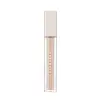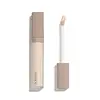What's inside
What's inside
 Key Ingredients
Key Ingredients

 Benefits
Benefits

 Concerns
Concerns

 Ingredients Side-by-side
Ingredients Side-by-side

Water
Skin ConditioningTitanium Dioxide
Cosmetic ColorantCyclopentasiloxane
EmollientPhenyl Trimethicone
Skin ConditioningButylene Glycol
HumectantCetyl PEG/PPG-10/1 Dimethicone
EmulsifyingCI 77492
Cosmetic ColorantBoron Nitride
AbsorbentTrimethylsiloxysilicate
EmollientPEG-10 Dimethicone
Skin ConditioningVinyl Dimethicone/Methicone Silsesquioxane Crosspolymer
Sodium Chloride
Masking1,2-Hexanediol
Skin ConditioningAluminum Hydroxide
EmollientTriethoxycaprylylsilane
CI 77491
Cosmetic ColorantDisteardimonium Hectorite
StabilisingQuaternium-18 Bentonite
Caprylyl Glycol
EmollientCI 77499
Cosmetic ColorantTocopheryl Acetate
AntioxidantMelaleuca Alternifolia Leaf Extract
PerfumingWater, Titanium Dioxide, Cyclopentasiloxane, Phenyl Trimethicone, Butylene Glycol, Cetyl PEG/PPG-10/1 Dimethicone, CI 77492, Boron Nitride, Trimethylsiloxysilicate, PEG-10 Dimethicone, Vinyl Dimethicone/Methicone Silsesquioxane Crosspolymer, Sodium Chloride, 1,2-Hexanediol, Aluminum Hydroxide, Triethoxycaprylylsilane, CI 77491, Disteardimonium Hectorite, Quaternium-18 Bentonite, Caprylyl Glycol, CI 77499, Tocopheryl Acetate, Melaleuca Alternifolia Leaf Extract
CI 77891
Cosmetic ColorantWater
Skin ConditioningCyclopentasiloxane
EmollientPhenyl Trimethicone
Skin ConditioningMica
Cosmetic ColorantButylene Glycol
HumectantCetyl PEG/PPG-10/1 Dimethicone
EmulsifyingPvp
Emulsion StabilisingPEG-10 Dimethicone
Skin ConditioningCI 77492
Cosmetic ColorantCI 77120
Cosmetic ColorantVinyl Dimethicone/Methicone Silsesquioxane Crosspolymer
Sodium Chloride
MaskingDimethicone
EmollientDisteardimonium Hectorite
StabilisingAluminum Hydroxide
EmollientTriethoxycaprylylsilane
CI 77491
Cosmetic ColorantMethicone
EmollientPhenoxyethanol
PreservativePolysilicone-11
Palmitic Acid
EmollientChlorphenesin
AntimicrobialStearic Acid
CleansingSqualane
EmollientCI 77499
Cosmetic ColorantParfum
MaskingSimmondsia Chinensis Seed Oil
EmollientGlycerin
HumectantHelianthus Annuus Seed Oil Unsaponifiables
EmollientMyristic Acid
Cleansing1,2-Hexanediol
Skin ConditioningSolanum Lycopersicum Fruit Extract
AntioxidantBrassica Oleracea Gemmifera Extract
AstringentLecithin
EmollientSimmondsia Chinensis Leaf Extract
HumectantLeontopodium Alpinum Extract
Skin ConditioningAlcohol
AntimicrobialPhoenix Dactylifera Seed
Skin ConditioningHydrogenated Lecithin
EmulsifyingAscorbic Acid
AntioxidantGlycine
BufferingSerine
MaskingGlutamic Acid
HumectantTromethamine
BufferingDipotassium Glycyrrhizate
HumectantAspartic Acid
MaskingLeucine
Skin ConditioningSodium Metabisulfite
AntioxidantAlanine
MaskingLysine
Skin ConditioningArginine
MaskingTyrosine
MaskingPhenylalanine
MaskingValine
MaskingCeramide NP
Skin ConditioningThreonine
Proline
Skin ConditioningSodium Sulfite
PreservativeIsoleucine
Skin ConditioningHistidine
HumectantMethionine
Skin ConditioningCysteine
AntioxidantDunaliella Salina Extract
Skin ConditioningCI 77891, Water, Cyclopentasiloxane, Phenyl Trimethicone, Mica, Butylene Glycol, Cetyl PEG/PPG-10/1 Dimethicone, Pvp, PEG-10 Dimethicone, CI 77492, CI 77120, Vinyl Dimethicone/Methicone Silsesquioxane Crosspolymer, Sodium Chloride, Dimethicone, Disteardimonium Hectorite, Aluminum Hydroxide, Triethoxycaprylylsilane, CI 77491, Methicone, Phenoxyethanol, Polysilicone-11, Palmitic Acid, Chlorphenesin, Stearic Acid, Squalane, CI 77499, Parfum, Simmondsia Chinensis Seed Oil, Glycerin, Helianthus Annuus Seed Oil Unsaponifiables, Myristic Acid, 1,2-Hexanediol, Solanum Lycopersicum Fruit Extract, Brassica Oleracea Gemmifera Extract, Lecithin, Simmondsia Chinensis Leaf Extract, Leontopodium Alpinum Extract, Alcohol, Phoenix Dactylifera Seed, Hydrogenated Lecithin, Ascorbic Acid, Glycine, Serine, Glutamic Acid, Tromethamine, Dipotassium Glycyrrhizate, Aspartic Acid, Leucine, Sodium Metabisulfite, Alanine, Lysine, Arginine, Tyrosine, Phenylalanine, Valine, Ceramide NP, Threonine, Proline, Sodium Sulfite, Isoleucine, Histidine, Methionine, Cysteine, Dunaliella Salina Extract
 Reviews
Reviews

Ingredients Explained
These ingredients are found in both products.
Ingredients higher up in an ingredient list are typically present in a larger amount.
1,2-Hexanediol is a synthetic liquid and another multi-functional powerhouse.
It is a:
- Humectant, drawing moisture into the skin
- Emollient, helping to soften skin
- Solvent, dispersing and stabilizing formulas
- Preservative booster, enhancing the antimicrobial activity of other preservatives
Aluminum Hydroxide is a form of aluminum. It can be naturally found in nature as the mineral gibbsite. In cosmetics, Aluminum Hydroxide is used as a colorant, pH adjuster, and absorbent.
As a colorant, Aluminum Hydroxide may add opacity, or reduce the transparency. Aluminum hydroxide is contains both basic and acidic properties.
According to manufacturers, this ingredient is an emollient and humectant. This means it helps hydrate the skin.
In medicine, this ingredient is used to help relieve heartburn and help heal ulcers.
There is currently no credible scientific evidence linking aluminum hydroxide in cosmetics to increased cancer risk.
Major health organizations allow the use of aluminum hydroxide in personal care products and have not flagged it as a carcinogenic risk at typical usage levels.
Learn more about Aluminum HydroxideButylene Glycol (or BG) is used within cosmetic products for a few different reasons:
Overall, Butylene Glycol is a safe and well-rounded ingredient that works well with other ingredients.
Though this ingredient works well with most skin types, some people with sensitive skin may experience a reaction such as allergic rashes, closed comedones, or itchiness.
Learn more about Butylene GlycolThis ingredient is a high molecular weight silicone. It has emulsifying and skin conditioning properties.
Ci 77491 is also hydrated iron III oxide. It's sole purpose is to give a red/pink hue to products.
Iron III oxides are classified as inorganic chemicals for coloring.
Synthetically created Ci 77491 is considered safer than those naturally found. This is because the synthetically created version may contain less impurities. Iron oxides are generally non-toxic and non-allergenic.
Learn more about CI 77491Ci 77492 is also hydrated iron III oxide. It's sole purpose is to give a yellow hue to products.
Iron III oxides are classified as inorganic chemicals for coloring.
Synthetically created Ci 77492 is considered safer than those naturally found. This is because the synthetically created version may contain less impurities. Iron oxides are generally non-toxic and non-allergenic.
Learn more about CI 77492Ci 77499 is also hydrated iron III oxide. It is created from mixing red and black iron oxides. This helps give shades of darkness to a product.
Iron III oxides are classified as inorganic chemicals for coloring.
Cyclopentasiloxane, or D5, is a silicone used to improve texture of products and trap moisture.
D5 is considered lightweight and volatile. Volatile means it evaporates quickly after application. Once evaporated, D5 leaves a thin barrier that helps keep skin hydrated.
It is also an emollient. Emollients help soften the skin and prevent water loss. Silicones create a silky texture in products. D5 helps other ingredients become more spreadable.
Studies show D5 is safe to use in skincare products. We recommend speaking with a skincare professional if you have concerns.
Learn more about CyclopentasiloxaneDisteardimonium Hectorite comes from the clay mineral named hectorite. It is used to add thickness to a product.
It can also help stabilize a product by helping to disperse other ingredients.
Hectorite is a rare, white clay mineral.
Learn more about Disteardimonium HectoritePeg-10 Dimethicone is silicone with conditioner and emulsifier properties. It mostly acts as an emollient in skincare and and humectant in haircare.
According to the manufacturer, acidic formulations decrease the stability of this ingredient. It works best in neutral or near neutral formulations.
Phenyl Trimethicone is a silicon-based polymer. It is derived from silica.
Phenyl Trimethicone is used as an emollient and prevents products from foaming.
As an emollient, it helps trap moisture in the skin. It is considered an occlusive.
Learn more about Phenyl TrimethiconeChances are, you eat sodium chloride every day. Sodium Chloride is also known as table salt.
This ingredient has many purposes in skincare: thickener, emulsifier, and exfoliator.
You'll most likely find this ingredient in cleansers where it is used to create a gel-like texture. As an emulsifier, it also prevents ingredients from separating.
There is much debate on whether this ingredient is comedogenic. The short answer - comedogenic ratings don't tell the whole story. Learn more about comegodenic ratings here.
The concensus about this ingredient causing acne seems to be divided. Research is needed to understand if this ingredient does cause acne.
Scrubs may use salt as the primary exfoliating ingredient.
Learn more about Sodium ChlorideTriethoxycaprylylsilane is a silicone used to bind and stabilize ingredients.
As an emulsifier, it helps prevent ingredients from separating. This can help elongate the shelf life of products.
Triethoxycaprylylsilane is often used to coat mineral sunscreens ingredients to help give a better feel. It also helps reduce oxidative stress in sunscreens.
Learn more about TriethoxycaprylylsilaneThis ingredient is used in makeup and skincare to thicken formulas, reduce shine, and give skin a silky-smooth feel.
It’s a white silicone powder that sits in fine lines and pores to blur their appearance though its effectiveness depends on the particle size.
You'll typically find this ingredient in amounts between 0.1-20%.
Learn more about Vinyl Dimethicone/Methicone Silsesquioxane CrosspolymerWater. It's the most common cosmetic ingredient of all. You'll usually see it at the top of ingredient lists, meaning that it makes up the largest part of the product.
So why is it so popular? Water most often acts as a solvent - this means that it helps dissolve other ingredients into the formulation.
You'll also recognize water as that liquid we all need to stay alive. If you see this, drink a glass of water. Stay hydrated!
Learn more about Water